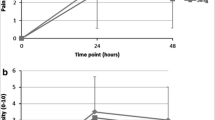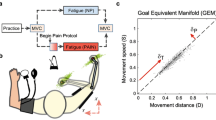Abstract
A reorganized motor control system is a key factor in musculoskeletal pain conditions, and its relevance in the transition from acute pain to chronic pain is most likely underestimated. The interaction between muscle pain and motor control depends on the specific motor task. Muscle pain causes no increase in electromyographic activity at rest and reduces maximal voluntary contraction and endurance time during submaximal contractions. Furthermore, muscle pain causes an adaptive change in the coordination during dynamic exercises. Increased muscle activity reflecting reorganized muscle coordination and strategy is also a component of the functional adaption to muscle pain. In general, the “vicious cycle” hypothesis is not supported by these findings. Instead, they support an adaptive model predicting reduced agonistic muscle activity eventually advanced by changed antagonistic muscle activity. The motor control assessment procedures provide complementary clinical information and give further support for optimizing treatment regimens and prevention procedures for musculoskeletal pain.
Similar content being viewed by others
References and Recommended Reading
Graven-Nielsen T: Fundamentals of muscle pain, referred pain, and deep tissue hyperalgesia. Scand J Rheumatol 2006, 35(Suppl 122):1–43.
Mense S, Hoheisel U: Morphology and functional types of muscle nociceptors. In Fundamentals of Musculoskeletal Pain. Edited by Graven-Nielsen T, Arendt-Nielsen L, Mense S. Seattle: IASP Press; 2008:3–17.
Cairns BE, Svensson P, Wang K, et al.: Activation of peripheral NMDA receptors contributes to human pain and rat afferent discharges evoked by injection of glutamate into the masseter muscle. J Neurophysiol 2003, 90:2098–2105.
Iggo A: Non-myelinated afferent fibres from mammalian skeletal muscle. J Physiol 1961, 155:52P–53P.
Schomburg ED, Steffens H: Only minor spinal motor reflex effects from feline group IV muscle nociceptors. Neurosci Res 2002, 44:213–223.
Travell JG, Rinzler S, Herman M: Pain and disability of the shoulder and arm. JAMA 1942, 120:417–422.
Johansson H, Sojka P: Pathophysiological mechanisms involved in genesis and spread of muscular tension in occupational muscle pain and in chronic musculoskeletal pain syndromes: a hypothesis. Medical Hypotheses 1991, 35:196–203.
Masri R, Ro JY, Capra N: The effect of experimental muscle pain on the amplitude and velocity sensitivity of jaw closing muscle spindle afferents. Brain Res 2005, 1050:138–147.
Lund JP, Stohler CS, Widmer CG: The relationship between pain and muscle activity in fibromyalgia and similar conditions. In Progress in Fibromyalgia and Myofascial Pain. Edited by Vaerøy H, Merskey H. Amsterdam: Elsevier Science Publishers; 1993:311–327.
Ashton-Miller JA, McGlashen KM, Herzenberg JE, Stohler CS: Cervical muscle myoelectric response to acute experimental sternocleidomastoid pain. Spine 1990, 15:1006–1012.
Stohler CS, Zhang X, Lund JP: The effect of experimental jaw muscle pain on postural muscle activity. Pain 1996, 66:215–221.
Svensson P, Graven-Nielsen T, Matre D, Arendt-Nielsen L: Experimental muscle pain does not cause long-lasting increases in resting electromyographic activity. Muscle Nerve 1998, 21:1382–1389.
Graven-Nielsen T, Svensson P, Arendt-Nielsen L: Effects of experimental muscle pain on muscle activity and co-ordination during static and dynamic motor function. Electroencephalogr Clin Neurophysiol 1997, 105:156–164.
Svensson P, Wang K, Sessle BJ, Arendt-Nielsen L: Associations between pain and neuromuscular activity in the human jaw and neck muscles. Pain 2004, 109:225–232.
Torisu T, Wang K, Svensson P, et al.: Effect of low-level clenching and subsequent muscle pain on exteroceptive suppression and resting muscle activity in human jaw muscles. Clin Neurophysiol 2007, 118:999–1009.
Torisu T, Wang K, Svensson P, et al.: Effects of muscle fatigue induced by low-level clenching on experimental muscle pain and resting jaw muscle activity: gender differences. Exp Brain Res 2006, 174:566–574.
Elert JE, Dahlqvist SB, Henriksson-Larsén K, Gerdle B: Increased EMG activity during short pauses in patients with primary fibromyalgia. Scand J Rheumatol 1989, 18:321–323.
Zidar J, Bäckman E, Bengtsson A, Henriksson KG: Quantitative EMG and muscle tension in painful muscles in fibromyalgia. Pain 1990, 40:249–254.
Bodéré C, Tea SH, Giroux-Metges MA, Woda A: Activity of masticatory muscles in subjects with different orofacial pain conditions. Pain 2005, 116:33–41.
Larsson R, Oberg PA, Larsson SE: Changes of trapezius muscle blood flow and electromyography in chronic neck pain due to trapezius myalgia. Pain 1999, 79:45–50.
Ahern DK, Follick MJ, Council JR, et al.: Comparison of lumbar paravertebral EMG patterns in chronic low back pain patients and non-patient controls. Pain 1988, 34:153–160.
Sessle BJ: Acute and chronic craniofacial pain: brainstem mechanisms of nociceptive transmission and neuroplasticity, and their clinical correlates. Crit Rev Oral Biol Med 2000, 11:57–91.
Graven-Nielsen T, Lund H, Arendt-Nielsen L, et al.: Inhibition of maximal voluntary contraction force by experimental muscle pain: a centrally mediated mechanism. Muscle Nerve 2002, 26:708–712.
Farina D: Effect of experimental muscle pain on motor unit properties. In Fundamentals of Musculoskeletal Pain. Edited by Graven-Nielsen T, Arendt-Nielsen L, Mense S. Seattle: IASP Press; 2008:461–475.
Bäckman E, Bengtsson A, Bengtsson M, et al.: Skeletal muscle function in primary fibromyalgia. Effect of regional sympathetic blockade with guanethidine. Acta Neurol Scand 1988, 77:187–191.
Slater H, Arendt-Nielsen L, Wright A, Graven-Nielsen T: Sensory and motor effects of experimental muscle pain in patients with lateral epicondylalgia and controls with delayed onset muscle soreness. Pain 2005, 114:118–130.
Falla D, Farina D, Dahl MK, Graven-Nielsen T: Muscle pain induces task-dependent changes in cervical agonist/antagonist activity. J Appl Physiol 2007, 102:601–609.
Farina D, Arendt-Nielsen L, Merletti R, Graven-Nielsen T: Effect of experimental muscle pain on motor unit firing rate and conduction velocity. J Neurophysiol 2004, 91:1250–1259.
Madeleine P, Leclerc F, Arendt-Nielsen L, et al.: Experimental muscle pain changes the spatial distribution of upper trapezius muscle activity during sustained contraction. Clin Neurophysiol 2006, 117:2436–2445.
Hodges PW, Ervilha UF, Graven-Nielsen T: Changes in motor unit firing rate in synergist muscles cannot explain the maintenance of force during constant force painful contractions. J Pain 2008 (in press).
Ciubotariu A, Arendt-Nielsen L, Graven-Nielsen T: Localized muscle pain causes prolonged recovery after fatiguing isometric contractions. Exp Brain Res 2007, 181:147–158.
Bengtsson A, Bäckman E, Lindblom B, Skogh T: Long term follow-up of fibromyalgia patients: Clinical symptoms, muscular function, laboratory test-an eight year comparison study. J Musculoskel Pain 1994, 2:67–80.
Prasartwuth O, Taylor JL, Gandevia SC: Maximal force, voluntary activation and muscle soreness after eccentric damage to human elbow flexor muscles. J Physiol 2005, 567:337–348.
Hedayatpour N, Falla D, Arendt-Nielsen L, Farina D: Sensory and electromyographic mapping during delayed-onset muscle soreness. Med Sci Sports Exerc 2008, 40:326–334.
Bajaj P, Madeleine P, Sjogaard G, Arendt-Nielsen L: Assessment of postexercise muscle soreness by electromyography and mechanomyography. J Pain 2002, 3:126–136.
Kroon GW, Naeije M: Recovery of the human biceps electromyogram after heavy eccentric, concentric or isometric exercise. Eur J Appl Physiol Occup Physiol 1991, 63:444–448.
Nie H, Arendt-Nielsen L, Kawczynski A, Madeleine P: Gender effects on trapezius surface EMG during delayed onset muscle soreness due to eccentric shoulder exercise. J Electromyogr Kinesiol 2007, 17:401–409.
Arendt-Nielsen L, Graven-Nielsen T, Svarrer H, Svensson P: The influence of low back pain on muscle activity and coordination during gait: a clinical and experimental study. Pain 1996, 64:231–240.
Sihvonen T, Partanen J, Hänninen O, Soimakallio S: Electric behavior of low back muscles during lumbar pelvic rhythm in low back pain patients and healthy controls. Arch Phys Med Rehabil 1991, 72:1080–1087.
Hodges PW: Changes in sensorimotor control in low back pain. In Fundamentals of Musculoskeletal Pain. Edited by Graven-Nielsen T, Arendt-Nielsen L, Mense S. Seattle: IASP Press; 2008:445–459.
Ervilha UF, Arendt-Nielsen L, Duarte M, Graven-Nielsen T: Effect of load level and muscle pain intensity on the motor control of elbow-flexion movements. Eur J Appl Physiol 2004, 92:168–175.
Madeleine P, Voigt M, Arendt-Nielsen L: Reorganisation of human step initiation during acute experimental muscle pain. Gait Posture 1999, 10:240–247.
Falla D, Farina D, Graven-Nielsen T: Experimental muscle pain results in reorganization of coordination among trapezius muscle subdivisions during repetitive shoulder flexion. Exp Brain Res 2007, 178:385–393.
Henriksen M, Alkjaer T, Lund H, et al.: Experimental quadriceps muscle pain impairs knee joint control during walking. J Appl Physiol 2007, 103:132–139.
Matre DA, Sinkaer T, Svensson P, Arendt-Nielsen L: Experimental muscle pain increases the human stretch reflex. Pain 1998, 75:331–339.
Birznieks I, Burton AR, Macefield VG: The effects of experimental muscle and skin pain on the static stretch sensitivity of human muscle spindles in relaxed leg muscles. J Physiol 2008, 586:2713–2723.
Wang K, Svensson P, Arendt-Nielsen L: Modulation of exteroceptive suppression periods in human jaw-closing muscles by local and remote experimental muscle pain. Pain 1999, 82:253–262.
Rossi A, Mazzocchio R, Decchi B: Effect of chemically activated fine muscle afferents on spinal recurrent inhibition in humans. Clin Neurophysiol 2003, 114:279–287.
Martin PG, Weerakkody N, Gandevia SC, Taylor JL: Group III and IV muscle afferents differentially affect the motor cortex and motoneurones in humans. J Physiol 2008, 586:1277–1289.
Le Pera D, Graven-Nielsen T, Valeriani M, et al.: Inhibition of motor system excitability at cortical and spinal level by tonic muscle pain. Clin Neurophysiol 2001, 112:1633–1641.
Author information
Authors and Affiliations
Corresponding author
Rights and permissions
About this article
Cite this article
Graven-Nielsen, T., Arendt-Nielsen, L. Impact of clinical and experimental pain on muscle strength and activity. Curr Rheumatol Rep 10, 475–481 (2008). https://doi.org/10.1007/s11926-008-0078-6
Published:
Issue Date:
DOI: https://doi.org/10.1007/s11926-008-0078-6




